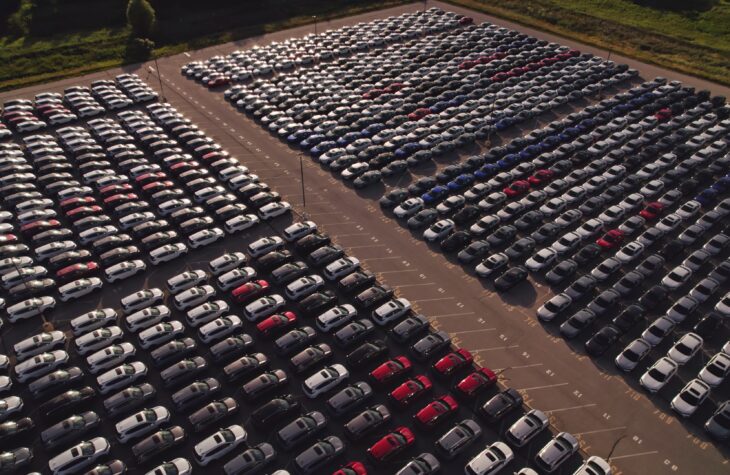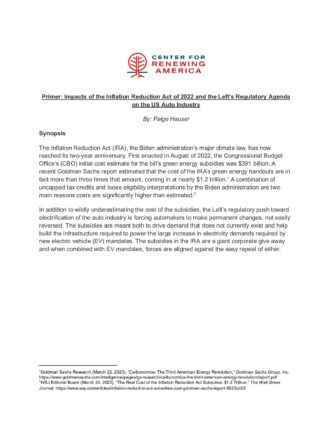
Primer: Impacts of the Inflation Reduction Act of 2022 and the Left’s Regulatory Agenda on the US Auto Industry
Synopsis
The Inflation Reduction Act (IRA), the Biden administration’s major climate law, has now reached its two-year anniversary. First enacted in August of 2022, the Congressional Budget Office’s (CBO) initial cost estimate for the bill’s green energy subsidies was $391 billion. A recent Goldman Sachs report estimated that the cost of the IRA’s green energy handouts are in fact more than three times that amount, coming in at nearly $1.2 trillion.1 A combination of uncapped tax credits and loose eligibility interpretations by the Biden administration are two main reasons costs are significantly higher than estimated.2
In addition to wildly underestimating the cost of the subsidies, the Left’s regulatory push toward electrification of the auto industry is forcing automakers to make permanent changes, not easily reversed. The subsidies are meant both to drive demand that does not currently exist and help build the infrastructure required to power the large increase in electricity demands required by new electric vehicle (EV) mandates. The subsidies in the IRA are a giant corporate give away and when combined with EV mandates, forces are aligned against the easy repeal of either.
Inflation Reduction Act Green Energy Tax Credits
Source: The Tax Foundation available at: https://taxfoundation.org/research/all/federal/inflation-reduction-act-taxes/
In Focus: Exploding Cost Estimates
Researchers from the Mercatus Center found the true cost for both the wind energy production credit and the advanced manufacturing production credit (specifically for manufacturers of EV battery cells) to be as high as $68.4 billion and $196.5 billion. CBO’s original estimates for those programs were $11.2 billion and $30.6 billion respectively–cost overruns of 511 percent and 542 percent beyond the original estimations.3
The wind production credit provides a corporate tax credit equal to 2.75 cents per kilowatt hour for electricity generated by wind and closed-loop energy sources. The U.S. Geological Survey reports the average annual output capacity of recently built wind turbines to be about 42 percent; and at that capacity factor, the price tag for the credit is much higher, $68.4 billion. A wind turbine with lower capacity would mean fewer kilowatt hours generated and a lower credit price tag, which is perhaps the reason for CBO’s lower estimate. The credit for battery manufacturing is a direct transfer, payable regardless of whether the entity possesses a tax liability, and depends on per kilowatt hour of capacity or 10 percent for the production of critical minerals.4
These two credits alone underscore the rapid escalation of costs of the IRA and further expose the long-running history of faulty cost estimations provided for these massive legislative boondoggles. In addition to higher than expected costs further burdening taxpayers and compounding the nation’s deepening debt crisis, most of the IRA subsidies have been claimed by the wealthy and well-connected corporations with significant direct and indirect benefits to China.
Analysis: Fiscal Impacts of the IRA’s Green New Deal Boondoggle
While the Biden administration presented the Inflation Reduction Act as a means of containing the record inflation destroying household incomes, the legislation was in truth a legislative vehicle for enacting large swaths of the radical Green New Deal. Specifically, the bill supercharged federal climate change initiatives through the issuance of exorbitant green tax credits and expanded taxpayer-funded grant programs to left-wing interest groups and causes.
The IRA’s exorbitant taxpayer-funded Green New Deal infrastructure perpetuates a simmering inflationary pressure on hardworking households and small businesses by incentivizing the use and adoption of costlier inputs, costs inevitably passed on to consumers. For example, the IRA extended the biodiesel and renewable diesel tax credit and created a slew of new renewable fuel credits, such as the Clean Fuel Production Credit, that artificially inflates the cost of transportation fuel and production inputs through federal subsidies. The cost projections for these credits fluctuate widely depending on the fiscal assumptions, but in total the cost of these particular biofuel credits are well north of $10 billion just through 2025.5 It is no coincidence that the nationwide average retail price for diesel remains 37 percent higher at $3.72 per gallon in July 2024 than $2.72 per gallon in January 2021.
While the average retail price has dropped from previous record highs in 2022 and 2023, the sustained elevation of diesel prices is in part perpetuated by extended and expanded federal largesse in the form of biodiesel tax credits. Increased diesel costs feed directly into price increases for goods and services, maintaining inflationary pressure on households and businesses.6
While the negative impacts of the federal government’s Green New Deal central planning is overwhelmingly felt by working and middle-class households, it is the wealthy and well-connected that stand to directly benefit the most as taxpayers are depleted of their resources.
For example, the majority (78 percent) of electric vehicle (EV) tax credits are claimed by those making $100,000 or more per year.7 Because the average EV costs over $17,000 more than its gas-powered equivalent, the wealthy are best positioned to afford them.8 The wealthy were early adopters of EVs but as that initial demand has worn off auto makers have been forced to drop prices in search of new customers.9 Beyond the EV credits, over 90 percent of green energy tax subsidies are claimed by corporations that make over $1 billion per year, and financial institutions receive three times the benefit from the credits than other industries.10 Specifically, banks and insurers alone receive over half of the green energy tax breaks.11
Domestically, the wealthy and corporations gain the most, but the green programs also directly benefit the Chinese. China is responsible for 77 percent of the world’s EV manufacturing. China dominates the supply chain for every critical mineral necessary for renewable energy technology. According to the International Energy Agency, 80 percent of the world’s rare earth minerals and about 60 percent of its lithium are processed in China.12
The automaker, Ford recently announced it would put its plans for a $3.5 billion battery plant in Michigan on hold after making a deal with the Chinese company, CATL to manufacture the battery cells using CATL’s lithium iron phosphate (LFP) battery technology and services. It appears the factory was put on hold because of concerns over CATL’s links to the Chinese Communist Party, which have led to a Congressional subpoena.13
A recent analysis by the Coalition for a Prosperous America found that Chinese companies could end up with $125 billion in Inflation Reduction Act subsidies.14 This is unsurprising, since about 80 percent of the world’s renewable energy equipment comes from China. For example, eight of the 10 largest solar equipment makers are headquartered in China, and China dominates 80 percent of the world’s solar panel supply chain.15 Ten of the 15 largest wind equipment makers are Chinese.
Analysis: Incentivizing the Collapse of the American Auto Industry
The Biden administration has also enacted regulations16 that will require two out of every three cars sold to be battery electric by 2032. The fuel economy rules from the National Highway Traffic Safety Administration require automakers to reach a fleetwide average of about 58 miles per gallon by 2032. Preliminary data indicates automakers were able to achieve only 26.9 mpg in model year 2023, with electric vehicles of all types making up about 16 percent of sales.17 The Biden EPA is requiring automakers achieve carbon dioxide emissions at 82 grams per mile in model year 2032. For reference, the average new vehicle in 2021 emitted 347 grams per mile of carbon dioxide. The EPA also allowed California to set its own more stringent rules, which 15 other states have adopted, that will ban the sale of new internal combustion engine, that is gasoline fueled vehicles in those states by 2035. Those states combined make up about 40 percent of the US car market.18
The impact of electrification by political decree through the IRA’s EV tax credits and the Biden EV mandate will have on the American auto industry—and the ability of Americans to purchase affordable vehicles—looks bleak. Families are already struggling with sustained increases in the price of new and used vehicles. Hundreds of billions thrown at manufacturers to artificially create demand for EVs coupled with mandates on the automakers to only produce electric vehicles could trigger significant and devastating economic consequences.
In total, the Inflation Reduction Act’s (IRA) energy tax credits are estimated to cost nearly $1 trillion over the next decade with $180 billion of that cost reserved for electric vehicle (EV) infrastructure. The legislation supercharged the tax credits, removing an eligibility requirement that the existing $7,500 credit only go to manufacturers who had produced fewer than 200,000 EVs. The IRA repealed this manufacturing limitation and created additional tax credits for used and commercial EVs.
The Biden administration’s EV mandates force automakers to produce EVs that end up sitting on car lots for weeks. Some automakers have gone all in on EVs; General Motors (GM) and Volkswagen are two notable examples. Meanwhile, others like Toyota have opted for plug-in hybrids, which give optionality that fully electric vehicles do not. Some who went all in on EVs have been forced to take massive losses. For example Ford’s EV unit saw its revenues drop 84% to about $100 million and resulted in $1.3 billion loss before interest and taxes in just the first quarter. Ford expects total losses to be $5 billion for the year.19
Toyota, having resisted political pressure to go exclusively electric, opted to maintain optionality for its customers with plug-in hybrids, which paid off as it weathered the recent dip in EV sales very well. But it too is being forced to make the switch to electrification. Toyota said its operating profit jumped 77% ($7.34 billion), compared with the same period in 2023, but expects profits will fall 20% in the current financial year in part due to increased but undisclosed spending on EVs.20 It will comply with EV mandates committing to make all its products carbon neutral by 2050, while its Lexus brand will be exclusively battery electric by 2035.
Attempting to force American consumers to switch to costly EVs has been an ongoing and unmitigated disaster. For example, the $7.5 billion allocated for EV charging infrastructure in the Infrastructure Investment and Jobs Act (IIJA) of 2021 has resulted in the construction of just seven charging stations–more than $1 billion per charging station–after almost three years.
Americans want reliable and affordable energy—especially when it comes to powering their vehicles. The IRA’s attempts to piggyback off progressive state initiatives to ban the internal combustion engine—specifically California’s net-zero emissions legislation—is a hammer-and-anvil approach that empowers special interests with ties to communist China. Furthermore, the Biden administration created regulatory guidance that effectively waives the IRA’s prohibitions on hostile foreign powers from benefiting, and provides an exemption allowing for credits to flow to vehicles whose batteries contain parts and elements made in China, Russia, or Iran.
The combination of persistent inflation—largely derived from the Biden administration’s profligate spending binges in the IIJA, IRA, and other laws—and distortionary handouts to special interests has put American car manufacturers in a bind. The federal government is coercing manufacturers to produce vehicles that no one is buying through taxpayer-funded EV credits while simultaneously ensuring that even gas-powered cars remain increasingly unaffordable and eventually banned. On average, new car prices are 30 percent higher than they were in March 2020. Used car prices are up nearly 35 percent over the same period.
The push for all EVs is premature at best. To achieve 2035 targets some 300 new lithium mines will need to come online. Current lead times for a new mine are almost 20 years. Without raw materials, final production will be hampered and bottom lines will inevitably suffer. That assumes demand can be manufactured to buy the mandated product. That is itself an open question. There is also so-called “range anxiety;” the driver of an EV can only go so far before the battery will need recharging. A public fast charger can take anywhere from 20 minutes to an hour to get to 80 percent. To charge all these new EVs will take 1.2 million new public chargers in addition to 28 million private at home chargers. Finally, there are costs to consider. The average cost of a battery EV is $58,000 plus $1,300 for an at home charger, well outside the budget of many buyers even with generous subsidies.
Perhaps all those obstacles can be overcome, yet there is still the problem of powering all those charging stations. That requires an electric grid fully and reliably operating at capacity loads well beyond what are currently needed. Prospects for that are in doubt given that current demands on the grid are increasingly too taxing. According to the US Energy Information Agency (EIA), wind and solar made up 12 percent of US electricity generation in 2021, yet they estimated the IRA could increase it to nearly 60 percent by 2050, reducing reliable generation, mainly from coal in the process. According to the National Renewable Energy Laboratory, the massive electrification of US energy systems contemplated under the IRA would require a doubling of US generation capacity by 2050. They also found that the grid could be 90 percent carbon-free by 2030 with IRA tax credits. Massively increasing electricity demand while simultaneously switching to unreliable wind and solar for the bulk of generation to the grid, while retiring more reliable generation from fossil fuels, is a recipe for an energy crisis.
This policy-created pressure cooker is driving down demand from consumers, increasing the cost of inputs on the production end, misaligning production incentives for manufacturers, and resulting in declining or stagnant sales. Heading into 2025, a record 36 new vehicles are planned to launch with more than 50 percent being EVs.
The concern is that the artificially-created supply will fail to meet the demand, as many consumers will remain unable to purchase more expensive EVs. Automakers and dealers will lose money as vehicles sit idle on lots despite federal subsidies while consumer demand for traditional vehicles that utilize reliable fuel and make use of the internal combustion engine will increase. This could potentially create a reverse squeeze, wherein demand for non-EV automobiles will increase while government incentives and mandates create a reduced supply, thereby keeping prices high for both new and used traditional cars.
While the wealthy will have an easier time adapting, this prospective scenario leaves middle and low-income households with few options, unable to afford costly EVs and priced out of more traditional vehicles due to central-planning schemes gone bad.
If the American auto industry is going to be saved, and if working households are going to be protected, the IRA’s EV tax credits and the Left’s EV mandates must be repealed.
Conclusion
After two years, the IRA has proven to be significantly more expensive than originally estimated, further burdening taxpayers and compounding the nation’s deepening debt crisis at a time when inflation is too high and these costs will increase on autopilot. Most of the IRA subsidies have been claimed by the wealthy and well-connected corporations with significant direct and indirect benefits to China. The various credits incentivize and EV mandates dictate that automakers produce EVs for which there is little actual demand. At the same time, the IRA deepens dependence on unreliable renewables for electricity while simultaneously raising demand (via EVs), which could result in an energy crisis and further contribute to grid instability. Repealing the IRA subsidies and EV mandates is the first step in stopping a corporate gravy train that is hurting everyday Americans, reducing costs, and increasing the supply of reliable energy.
End Notes
- 1. Goldman Sachs Research (March 22, 2023). “Carbonomics: The Third American Energy Revolution,” Goldman Sachs Group, Inc. https://www.goldmansachs.com/intelligence/pages/gs-research/carbonomics-the-third-american-energy-revolution/report.pdf
- 2. WSJ Editorial Board (March 24, 2023). “The Real Cost of the Inflation Reduction Act Subsidies: $1.2 Trillion,” The Wall Street Journal. https://www.wsj.com/articles/inflation-reduction-act-subsidies-cost-goldman-sachs-report-5623cd29
- 3. https://www.forbes.com/sites/christinemcdaniel/2023/03/08/the-costs-of-wind-production-tax-credits-provided-in-the-ira/?sh=18ee336c5ff7 and https://www.forbes.com/sites/christinemcdaniel/2023/02/01/the-cost-of-battery-production-tax-credits-provided-in-the-ira/?sh=74ebd3bd79ef
- 4. https://crsreports.congress.gov/product/pdf/R/R47202
- 5. Agriculture, Budget, and Tax Analysis (March 12, 2024). “Biofuel Tax Credits Contribute to Burgeoning Budget Deficit,” Taxpayers for Common Sense. https://www.taxpayer.net/agriculture/biofuel-tax-credits-contribute-to-burgeoning-budget-deficit/
- 6. Nerkar, S. and Krauss, C. (October 5, 2023). “Diesel Prices Could Keep Inflation High,” The New York Times. https://www.nytimes.com/2023/10/05/business/energy-environment/diesel-prices-inflation.html
- 7. https://sgp.fas.org/crs/misc/IF11017.pdf#:~:text=EV%20tax%20credits%20are%20disproportionately%20claimed%20by%20higher-income,proportion%20%2883%25%29%20of%20the%20amount%20of%20credits%20claimed.
- 8. https://www.familyhandyman.com/article/electric-vehicle-costs/
- 9. https://www.cnn.com/2024/04/22/cars/tesla-price-war-china-germany-us-intl-hnk/index.html
- 10. https://waysandmeans.house.gov/2023/04/18/breaking-analysis-jct-confirms-green-new-deal-tax-breaks-flowing-to-big-banks-and-other-billion-dollar-corporations/
- 11. ibid
- 12. https://interestingengineering.com/innovation/china-becomes-solar-energy-superpower-dominates-80-of-supply-chain
- 13. https://www.forbes.com/sites/christinemcdaniel/2023/09/29/fords-battery-saga-a-glimpse-into-the-turbulent-ev-transition/?sh=5946fd397c3c
- 14. https://prosperousamerica.org/chinese-manufacturers-could-earn-up-to-125-billion-in-u-s-renewable-energy-tax-credits/
- 15. https://interestingengineering.com/innovation/china-becomes-solar-energy-superpower-dominates-80-of-supply-chain
- 16. https://www.bloomberg.com/news/articles/2023-11-28/car-dealers-press-biden-to-ease-push-toward-electric-vehicle-mandates?embedded-checkout=true
- 17. https://www.epa.gov/automotive-trends/explore-automotive-trends-data
- 18. https://electrek.co/2022/08/25/ca-finalizes-2035-gas-car-ban-a-huge-deal-but-why-not-sooner/
- 19. https://www.cnn.com/2024/04/24/business/ford-earnings-ev-losses/index.html
- 20. Hybrids Allow Toyota To Exploit Electric Pause, But Big EV Spend Looms (forbes.com)





